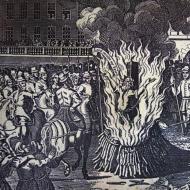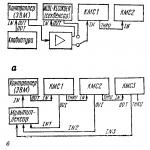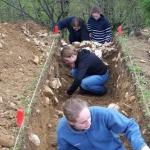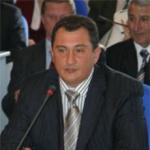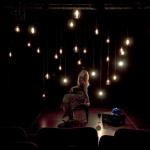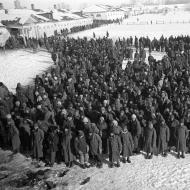
Burning at the stake of Giordano Bruno. Eternal Heretic
“The term “pseudoscience” goes back to the Middle Ages. We can remember Copernicus, who was burned because he said “But the Earth still rotates”…” The author of this fantastic quote, where three different people are confused, is politician Boris Gryzlov.
In fact, Galileo Galilei was persecuted for heliocentrism (the idea that the center of our planetary system is the Sun). The great astronomer was forced to renounce his views, but the phrases “But still it spins!” he did not say - this is a late legend. Nicolaus Copernicus, who lived earlier, the founder of heliocentrism and a Catholic clergyman, also died a natural death (his doctrine was officially condemned only 73 years later). But Giordano Bruno was burned on February 17, 1600 in Rome on charges of heresy.
There are many myths surrounding this name. The most common of them sounds something like this: “The cruel Catholic Church burned a progressive thinker, scientist, follower of Copernicus’s ideas that the Universe is infinite and the Earth revolves around the Sun.”
Back in 1892, a biographical essay by Julius Antonovsky “Giordano Bruno. His life and philosophical activity." This is a real “life of a saint” of the Renaissance. It turns out that the first miracle happened to Bruno in infancy - a snake crawled into his cradle, but the boy scared his father with a cry, and he killed the creature. Further more. Since childhood, the hero has been distinguished by outstanding abilities in many areas, fearlessly argues with opponents and defeats them with the help of scientific arguments. As a very young man, he gained all-European fame and, in the prime of his life, fearlessly died in the flames of a fire.
A beautiful legend about a martyr of science who died at the hands of medieval barbarians, from the Church, which “has always been against knowledge.” So beautiful that for many the real person ceased to exist, and in his place a mythical character appeared - Nikolai Brunovich Galilei. He lives a separate life, moves from one work to another and convincingly defeats imaginary opponents.
But this has nothing to do with the real person. Giordano Bruno was an irritable, impulsive and explosive man, a Dominican monk, and a scientist more in name than in essence. His “one true passion” turned out to be not science, but magic and the desire to create a unified world religion based on ancient Egyptian mythology and medieval Gnostic ideas.
Here, for example, is one of the spells for the goddess Venus, which can be found in the works of Bruno: “Venus is good, beautiful, most beautiful, amiable, benevolent, merciful, sweet, pleasant, shining, starry, Dionea, fragrant, cheerful, Afrogenia, fertile, merciful , generous, beneficent, peaceful, graceful, witty, fiery, the greatest reconciler, the mistress of love” (F. Yeats. Giordano Bruno and the Hermetic Tradition. M.: New Literary Review, 2000).
It is unlikely that these words would be appropriate in the works of a Dominican monk or an astronomer. But they are very reminiscent of the conspiracies that some “white” and “black” magicians still use.
Bruno never considered himself a student or follower of Copernicus and studied astronomy only to the extent that it helped him find “strong witchcraft” (to use an expression from the “goblin translation” of “The Lord of the Rings”). This is how one of the listeners of Bruno’s speech in Oxford (admittedly rather biased) describes what the speaker was talking about: “He decided, among many other questions, to expound the opinion of Copernicus that the earth goes in a circle, and the heavens are at rest; although in fact it was his own head that was spinning and his brain could not calm down” (quote from the above-mentioned work by F. Yeats).
Bruno patted his senior comrade on the shoulder in absentia and said: yes, to Copernicus “we owe liberation from some false assumptions of general vulgar philosophy, if not from blindness.” However, “he was not far from them, since, knowing mathematics more than nature, he could not go so deep and penetrate into the latter as to destroy the roots of difficulties and false principles.” In other words, Copernicus operated with exact sciences and did not seek secret magical knowledge, therefore, from Bruno’s point of view, he was not “advanced” enough.
Many readers of the fiery Giordano could not understand why among his works on the art of memorization or the structure of the world there were some crazy schemes and references to ancient and ancient Egyptian gods. In fact, these were the most important things for Bruno, and the mechanisms of memory training and descriptions of the infinity of the Universe were just a cover. Bruno, no less, called himself the new apostle.
Such views brought the philosopher to the stake. Unfortunately, the full text of Bruno's verdict has not been preserved. From the documents that have reached us and the testimony of contemporaries, it follows that Copernican ideas, which the defendant expressed in his own way, were also among the accusations, but did not make a difference in the inquisitorial investigation.
This investigation lasted eight years. The inquisitors tried to understand in detail the views of the thinker and carefully study his works. All eight years he was persuaded to repent. However, the philosopher refused to admit the accusations made. As a result, the inquisitorial tribunal declared him an “impenitent, stubborn and inflexible heretic.” Bruno was deprived of the priesthood, excommunicated from the church and executed (V.S. Rozhitsyn. Giordano Bruno and the Inquisition. M.: USSR Academy of Sciences, 1955).
Of course, imprisoning a person and then burning him at the stake just because he expressed certain views (even false ones) is unacceptable for people of the 21st century. And even in the 17th century, such measures did not add to the popularity of the Catholic Church. However, this tragedy cannot be viewed as a struggle between science and religion. Compared to Giordano Bruno, the medieval scholastics are more reminiscent of modern historians defending traditional chronology from the fantasies of Academician Fomenko, rather than stupid and limited people who fought against advanced scientific thought.
The story of Giordano Bruno is similar to a twisted detective story that humanity has been reading for more than four centuries, but cannot reach the end.
Lost Cause
“Detective,” whose main character is Giordano Bruno, could begin with a “flash-forward” to 1809, when Emperor Napoleon ordered the removal of papal Inquisition documents from the secret archives of the Vatican. Among the requisitioned papers was allegedly Bruno’s file, which included interrogation protocols and the text of the verdict itself. After the return of the Bourbon dynasty to the French throne, the Vatican requested the return of the documents. But Rome was disappointed: the French reported that part of the Inquisition archive had disappeared without a trace. However - oh, miracle! – the papers were soon found. They were discovered by Gaetano Marini, the Pope's envoy in Paris, "in the shops of herring and meat dealers." The secret archives found their way into the Parisian grocery stores thanks to another representative of the Roman Curia, who sold them to shopkeepers as packaging. Having received an order from Rome to destroy particularly delicate papers from the archives of the inquisitors, Gaetano Marini found nothing better than to sell them as waste paper to a Parisian paper mill.
It would seem that this is the end of the story, but in 1886 a second miracle occurs - one of the Vatican archivists accidentally stumbles upon Bruno’s case in the dusty archives of the pontiff, which he immediately reports to Pope Leo XIII. How the documents were teleported from the French paper mill to Rome remains a mystery? As well as how much you can trust the authenticity of these documents. By the way, the Vatican for a long time did not want to share the find with the public. The Giordano case was not published until 1942.
Why was a fire lit in Rome's Square of Flowers?
There were some surprises too. The verdict against Giordano Bruno said nothing about his scientific beliefs - “The Earth is not the center of the Universe, which is infinite.” But “voluntary martyrdom” for science made Bruno an “icon” who inspired scientists to scientific exploits, and here it is! But the most curious thing in the verdict was that there was no specific indictment at all, except for the first sentence of the document: “You, brother Giordano Bruno, son of the late Giovanni Bruno, from Nola, about 52 years old, were already brought in eight years ago to the court of the Holy Office of Venice for declaring: it is the greatest blasphemy to say that bread was transformed into a body, etc.”
In his “Aesthetics of the Renaissance,” the Russian philosopher, professor Alexei Fedorovich Losev formulated an important task for historical science, which had been awaiting publication of the case for several decades: “The historian must clearly answer the question: Why, in the end, was Giordano Bruno burned?”
Royal friend
For the Vatican, the verdict of Giordano Bruno was not just a condemnation of a Dominican monk who had fallen into heresy. At the end of the 16th century, in terms of popularity among European intellectuals, Bruno could have given odds to modern cosmologist Stephen Hawking. Giordano Bruno maintained very friendly relations with the kings of France Henry III and Henry IV, the British Queen Elizabeth I, the Holy Roman Emperor Rudolf II and many other European “rulers”. With a snap of his fingers, he could receive a chair and a professor's robe at any European university, his books were published in the best printing houses, and the best minds of the continent dreamed of his patronage.
Giordano Bruno's main calling card was not cosmology, but his excellent memory. Bruno developed mnemonics (the art of memory), which was then at the height of fashion among intellectuals. They say that Giordano memorized thousands of books, ranging from the Holy Scriptures to Arabic alchemical treatises. It was the art of memorization that he taught to Henry III, who was proud of his friendship with the humble Dominican monk, and to Elizabeth I, who allowed Giordano to enter her chambers at any time, without reporting. In addition, the monarchs enjoyed how Bruno, with mocking grace, “knocked out” teams of Sorbonne and Oxford professors with his intellect on any issue.
For Giordano Bruno, intellectual combat was a kind of sport. For example, Oxford academics recalled that he could easily prove that black is white, that day is night, and the Moon is the Sun. His debating style was similar to boxer Roy Jones in the ring at his best - a comparison that boxing fans will understand well. It must be admitted that it was hardly thanks to Bruno’s supernatural memory alone that he found himself on friendly terms with the most influential monarchs of Europe.
As biographers recall, some invisible force moved this Dominican monk through the life, easily brought him to the best palaces of Europe, protected him from the persecution of the Inquisition (for Bruno often mentioned theology in his statements). However, unexpectedly this force failed in May 1592.
Denunciation
On the night of May 23-24, 1592, Venetian inquisitors arrested Giordano Bruno following a denunciation from the local patrician Giovanni Mocenigo. Bruno personally taught the latter - for a huge reward - the art of memory. However, at some point the monk got bored with it. He declared the student hopeless and decided to say goodbye. Mocenigo tried all possible methods to return the “guru”, but Bruno turned out to be adamant. Then the desperate student wrote a denunciation to the local Inquisition. To be brief, the informer claimed that his mentor violated Catholic dogmas, talked about some kind of “infinite worlds” and called himself a representative of a certain “new philosophy”.
It must be said that denunciations of violation of dogmas were the most common “signals” from honest citizens of the Inquisition. This was the most proven way to annoy a neighbor, a competing shopkeeper, a personal enemy... Most of these cases did not even reach the court, but in any case the Inquisition was obliged to respond to the “signal”. In other words, the arrest of Giordano Bruno can be considered “technical”. The prisoner himself generally took it as a joke. At the very first interrogations, he deftly brushed aside all accusations of heresy and friendly shared with the investigators his views on the structure of the Universe. However, this frankness of Bruno could in no way ease his situation. The fact is that the works of Copernicus, whose ideas he developed, were not prohibited (they would be prohibited only in 1616), so there were no grounds for arrest.
The monk was kept under investigation largely because of his harmfulness: he behaved too derogatorily with the inquisitors.
Having taught the “proud man” a lesson, the Venetians were about to let him go, but then a request came from Rome demanding that the heretic be “transported” to the Eternal City. The Venetians stood in a pose: “Why on earth?!” Venice is a sovereign republic!” Rome had to organize an entire embassy to Venice to convince. It is curious that the Venetian procurator Contarini firmly insisted that Giordano Bruno should remain in Venice. In his report to the Council of the Wise of Venice, he gave the following description: “One of the most outstanding and rare geniuses that can be imagined. He has extraordinary knowledge. He created a wonderful teaching."
However, Venice trembled under the pressure of the pope - Bruno went “in stages” to Rome.
Crusade against Aristotle
Now let's return to the denunciation of Giovanni Mocenigo - or rather one of its points, which states that Bruno considered himself a representative of a certain “new philosophy”. The Venetian inquisitors hardly paid any attention to this nuance of the accusation. But they were well familiar with this term in Rome.
The very concept of “New Philosophy” (or “New Universal Philosophy”) was introduced by the Italian philosopher Francesco Patrizi, who was very close to the papal curia. Patrizi argued that Aristotle's philosophy, which became the basis for medieval scholasticism and theology, was directly opposed to Christianity, since it denied the omnipotence of God.
The Italian philosopher saw this as the cause of all the discord that arose in the church, which resulted in the Protestant movements. Patruzi saw the restoration of a unified Church and the return of Protestants to its fold in the departure from scholasticism, built on Aristotle, and replacing it with a certain synthesis of Plato’s metaphysics, the views of the Neoplatonists and the pantheistic theosophical teaching of Hermes Trismegistus. This synthesis was called “New Universal Philosophy”. The idea of ousting Aristotle from European universities (primarily Protestant) and regaining the status of an intellectual center with the help of the “New Philosophy” was liked by many in the papal curia. Of course, Rome could not make the “New Universal Philosophy” its official doctrine, but the fact that in those days the papal throne patronized teachings alternative to Aristotle is beyond doubt. And here Giordano Bruno played his bright role. From 1578 to 1590, he made an unprecedented tour of the largest universities in European cities: Toulouse, Sorbonne, Oxford, Wittenberg, Marburg, Helmstadt, Prague. All of these universities were either “Protestant” or were influenced by Protestantism.
In his lectures or debates with local professors, Bruno undermined precisely the philosophy of Aristotle. His sermons about the movement of the Earth and the multitude of worlds questioned Ptolemaic cosmology, built precisely on the teachings of Aristotle.
In other words, Giordano Bruno clearly followed the strategy of the “New Philosophy”. Was he on a secret mission for Rome? Considering his “inviolability”, as well as his mysterious patronage, it is very likely.
Worse than the Knights Templar
Giordano Bruno spent eight years under investigation. This was a record for the proceedings of the Inquisition! Why so long? For comparison, the trial of the Templars lasted seven years, but there the case concerned the entire order. At the same time, as many as nine cardinals were involved in passing the verdict, which, let us recall, actually did not contain an indictment! Were the nine inquisitors general unable to find words to describe the “heretical” acts of a Dominican monk with a good memory?
One passage in the verdict is curious: “Moreover, we condemn, condemn and prohibit all of the above and other books and writings of yours, as heretical and erroneous, containing numerous heresies and errors. We command that from now on all your books, which are in the holy service and in the future will fall into her hands, be publicly torn up and burned in St. Peter before the steps, and as such were included in the list of prohibited books, and so be it as we have commanded.” But apparently the voice of the nine cardinals was so weak that Bruno’s books could be freely purchased in Rome and other Italian cities until 1609.
Another interesting detail: if in Venice Giordano Bruno very quickly makes excuses for accusations of violating Catholic dogmas, then in Rome he suddenly changes tactics and, according to the investigation materials, begins not only to admit it, but also to flaunt his anti-Christianity. At the trial, he even throws out to the judges:
“Perhaps you pronounce your sentence with more fear than I listen to it. I die a martyr voluntarily and I know that my soul will ascend to heaven with its last breath.”
Did the Venetian Inquisition really seem more convincing to Bruno in its ferocity, and did an atmosphere of humanism and philanthropy reign in the torture chambers of the Vatican?
Who burned at the stake?
The only written evidence of the execution of Giordano Bruno has reached us. The witness was a certain Kaspar Schoppe, a “repentant Lutheran” who went into the service of the cardinal. Schoppe wrote in a letter to his comrade that the “heretic” accepted death calmly: “Without repenting of his sins, Bruno went to the worlds he imagined to tell what the Romans were doing with blasphemers.” I wonder why Schoppe thought that Giordano Bruno’s heresy lay in his view of the Universe - nothing was said about this in the verdict?
Schoppe, by the way, pointed out in his letter to a friend one interesting detail - Giordano Bruno was taken to the stake with a gag in his mouth, which was not in the tradition of the Inquisitorial burnings. It is unlikely that the organizers of the execution were afraid of the possible dying curses of the condemned man - this, as a rule, was the format of any execution. As well as repentance. Why the gag? It is unlikely that in a matter of minutes of execution, even such an intellectual and polemicist as Bruno would have been able to convince the illiterate crowd of the infidelity of Aristotelian cosmology. Or the executioners were simply afraid that the condemned man, in a moment of absolute despair, would suddenly shout out the terrible: “I am not Giordano Bruno!”
Vladimir Legoyda
Despite the fact that the idea of religion as “the opium of the people” is no longer modern and relevant, many old views do not change and continue to wander from generation to generation. One of these ideas is the struggle between religion and science “not to the death, but to the death.” Supporters of this view habitually trump famous names: Copernicus, Galileo, Bruno. The most amazing thing is that the myths about these “martyrs of science” have become so firmly entrenched in everyday consciousness that sometimes it seems that they cannot be eradicated. Times change, history is subject to close and scrupulous analysis, but defenders of scientists allegedly offended by Christianity continue to accuse the “damned churchmen” of destroying science. The reason for the persistence of these myths is a topic for a separate serious conversation, involving both historians and cultural experts, as well as psychologists and sociologists. The purpose of our publications is somewhat different - to try to understand, firstly, what actually happened and, secondly, how much what happened relates to the conflict between religion and science, if such is possible at all. We talked about Galilee. Today we will talk about Giordano Bruno.
I'll start by stating a fact: Giordano Bruno (1548-1600) actually suffered at the hands of the inquisitors. On February 17, 1600, the thinker was burned in the Piazza des Flowers in Rome. Regardless of any interpretations and interpretations of events, the fact always remains: the Inquisition sentenced Bruno to death and carried out the sentence. Such a step can hardly be justified from the point of view of evangelical morality. Therefore, Bruno's death will forever remain a regrettable event in the history of the Catholic West. The question is different. For what Did Giordano Bruno get hurt? The existing stereotype of a science martyr does not even allow one to think about the answer. How for what? Naturally, for your scientific views! However, in reality this answer turns out to be at least superficial. But in fact, it is simply incorrect.
I'm making up hypotheses!
As a thinker, Giordano Bruno certainly had a great influence on the development philosophical tradition of his time and - indirectly - on the development of modern science, primarily as a successor to the ideas of Nicholas of Cusa, which undermined the physics and cosmology of Aristotle. Moreover, Bruno himself was neither a physicist nor an astronomer. The ideas of the Italian thinker cannot be called scientific, not only from the standpoint of modern knowledge, but also by the standards of 16th-century science. Bruno was not engaged in scientific research in the sense that those who really created science at that time were engaged in it: Copernicus, Galileo, and later Newton. The name Bruno is known today primarily because of the tragic ending of his life. At the same time, we can say with full responsibility that Bruno did not suffer for his scientific views and discoveries. Simply because... he didn't have any!
Bruno was a religious philosopher, not a scientist. Natural scientific discoveries interested him primarily as reinforcement of his views on completely non-scientific issues: the meaning of life, the meaning of the existence of the Universe, etc. Of course, in the era of the emergence of science, this difference (scientist or philosopher) was not as obvious as it is now. Soon after Bruno, one of the founders of modern science, Isaac Newton, would define this boundary as follows: “I invent no hypotheses!” (i.e. all my thoughts are confirmed by facts and reflect the objective world). Bruno "invented hypotheses." Actually, he didn’t do anything else.
Let's start with the fact that Bruno was disgusted by the dialectical methods known to him and used by scientists of that time: scholastic and mathematical. What did he offer in return? Bruno preferred to give his thoughts not the strict form of scientific treatises, but poetic form and imagery, as well as rhetorical colorfulness. In addition, Bruno was a proponent of the so-called Lullian art of linking thoughts - a combinatorial technique that involved modeling logical operations using symbolic notation (named after the medieval Spanish poet and theologian Raymond Lull). Mnemonics helped Bruno remember important images that he mentally placed in the structure of the cosmos and which were supposed to help him master divine power and comprehend the internal order of the Universe.
The most accurate and vital science for Bruno was... magic! The criteria of his methodology are poetic meter and Lullian art, and Bruno’s philosophy is a peculiar combination of literary motifs and philosophical reasoning, often loosely related to each other. It is therefore not surprising that Galileo Galilei, who, like many of his contemporaries, recognized Bruno’s outstanding abilities, never considered him a scientist, much less an astronomer. And in every possible way he avoided even mentioning his name in his works.
It is generally accepted that Bruno's views were a continuation and development of the ideas of Copernicus. However, facts indicate that Bruno’s acquaintance with the teachings of Copernicus was very superficial, and in the interpretation of the works of the Polish scientist, the Nolanian made very serious mistakes. Of course, Copernicus' heliocentrism had a great influence on Bruno and on the formation of his views. However, he easily and boldly interpreted the ideas of Copernicus, putting his thoughts, as already mentioned, in a certain poetic form. Bruno argued that the Universe is infinite and exists forever, that there are countless worlds in it, each of which in its structure resembles the Copernican solar system.
Bruno went much further than Copernicus, who showed extreme caution here and refused to consider the question of the infinity of the Universe. True, Bruno’s courage was based not on scientific confirmation of his ideas, but on the occult-magical worldview, which was formed in him under the influence of the ideas of Hermeticism, popular at that time. Hermeticism, in particular, assumed the deification of not only man, but also the world, therefore Bruno’s own worldview is often characterized as pantheistic(pantheism is a religious doctrine in which the material world is deified). I will give only two quotes from the Hermetic texts: “We dare to say that man is a mortal God and that the God of heaven is an immortal man. Thus, all things are governed by the world and man,” “The Lord of eternity is the first God, the world is the second, man is the third. God, the creator of the world and everything that it contains, controls this whole whole and subjects it to the control of man. This latter turns everything into the subject of his activity.” As they say, no comments.
Thus, Bruno cannot be called not only a scientist, but even a popularizer of the teachings of Copernicus. From the point of view of science itself, Bruno rather compromised the ideas of Copernicus, trying to express them in the language of magical superstitions. This inevitably led to a distortion of the idea itself and destroyed its scientific content and scientific value. Modern historians of science believe that in comparison with the intellectual exercises of Bruno, not only the Ptolemaic system, but also medieval scholastic Aristotelianism can be considered the standards of scientific rationalism. Bruno did not have any actual scientific results, and his arguments “in favor of Copernicus” were just a set of nonsense that primarily demonstrated the ignorance of the author.
Are God and the Universe “twin brothers”?
So, Bruno was not a scientist, and therefore it was impossible to bring against him the charges that, for example, were brought against Galileo. Why then was Bruno burned? The answer lies in his religious views. In his idea of the infinity of the Universe, Bruno deified the world and endowed nature with divine properties. This view of the Universe actually rejected Christian idea of God who created the world ex nihilo(out of nothing - lat.).
According to Christian views, God, being an absolute and uncreated Being, does not obey the laws of space-time created by Him, and the created Universe does not possess the absolute characteristics of the Creator. When Christians say, “God is Eternal,” it does not mean that He “will not die,” but that He does not obey the laws of time, He is outside of time. Bruno's views led to the fact that in his philosophy God dissolved in the Universe, between the Creator and creation, the boundaries were erased, the fundamental difference was destroyed. God in Bruno’s teaching, unlike Christianity, ceased to be a Person, which is why man became only a grain of sand in the world, just as the earthly world itself was only a grain of sand in Bruno’s “many worlds.”
The doctrine of God as a Person was fundamentally important for the Christian doctrine of man: man is personality, since he was created in the image and likeness Personalities- The Creator. The creation of the world and man is a free act of Divine Love. Bruno, however, also talks about love, but with him it loses its personal character and turns into cold cosmic aspiration. These circumstances were significantly complicated by Bruno’s passion for occult and hermetic teachings: the Nolan was not only actively interested in magic, but also, apparently, no less actively practiced the “magical art.” In addition, Bruno defended the idea of the transmigration of souls (the soul is capable of traveling not only from body to body, but also from one world to another), questioned the meaning and truth of the Christian sacraments (primarily the sacrament of Communion), ironized the idea of the birth of the God-man from the Virgin and etc. All this could not but lead to conflict with the Catholic Church.
“Hermeticism is a magical-occult teaching that, according to its adherents, goes back to the semi-mythical figure of the Egyptian priest and magician Hermes Trismegistus, whose name we meet in the era of the dominance of religious and philosophical syncretism of the first centuries of the new era, and expounded in the so-called “Corpus Hermeticum”... In addition, Hermeticism had extensive astrological, alchemical and magical literature, which was traditionally attributed to Hermes Trismegistus, who acted as the founder of the religion, herald and savior in esoteric Hermetic circles and Gnostic sects... The main thing that distinguished esoteric-occult teachings from Christian theology... was conviction in the divine - uncreated - essence of man and the belief that there are magical means of purifying man that return him to the state of innocence that Adam possessed before the Fall. Having been cleansed of sinful filth, a person becomes the second God. Without any help or assistance from above, he can control the forces of nature and thus fulfill the covenant given to him by God before his expulsion from paradise.”
Gaidenko P.P. Christianity and the genesis of modern European natural science // Philosophical and religious sources of science. M.: Martis, 1997. P. 57.
Why were the inquisitors afraid of the verdict?
From all this it inevitably follows that, firstly, the views of Giordano Bruno cannot be characterized as scientific. Therefore, in his conflict with Rome there was not and could not be a struggle between religion and science. Secondly, the ideological foundations of Bruno’s philosophy were very far from Christian. For the Church he was a heretic, and heretics at that time were burned.
It seems very strange to the modern tolerant consciousness that a person is sent to the stake for deifying nature and practicing magic. Any modern tabloid publication publishes dozens of advertisements about damage, love spells, etc.
Bruno lived in a different time: during the era of religious wars. The heretics in Bruno’s time were not harmless thinkers “not of this world” whom the damned inquisitors burned for no reason. There was a struggle. The struggle is not just for power, but a struggle for the meaning of life, for the meaning of the world, for a worldview that was affirmed not only with the pen, but also with the sword. And if power were seized, for example, by those who were closer to the views of the Nolanite, the fires would most likely continue to burn, as they burned in the 16th century in Geneva, where Calvinist Protestants burned Catholic inquisitors. All this, of course, does not bring the era of witch hunts closer to living according to the Gospel.
Unfortunately, the full text of the verdict with charges against Bruno has not been preserved. From the documents that have reached us and the testimony of contemporaries, it follows that those Copernican ideas that Bruno expressed in his own way and which were also included in the accusations did not make any difference in the inquisitorial investigation. Despite the ban on Copernicus’s ideas, his views, in the strict sense of the word, were never heretical for the Catholic Church (which, by the way, a little over thirty years after Bruno’s death largely predetermined the rather lenient sentence of Galileo Galilei). All this once again confirms the main thesis of this article: Bruno was not and could not be executed for scientific views.
Some of Bruno’s views, in one form or another, were characteristic of many of his contemporaries, but the Inquisition sent only a stubborn Nolanite to the stake. What was the reason for this sentence? Most likely, it is worth talking about a number of reasons that forced the Inquisition to take extreme measures. Don't forget that the investigation into Bruno's case lasted 8 years. The inquisitors tried to understand Bruno's views in detail, carefully studying his works. And, apparently, recognizing the uniqueness of the thinker’s personality, they sincerely wanted Bruno to renounce his anti-Christian, occult views. And they persuaded him to repent for all eight years. Therefore, Bruno’s famous words that the inquisitors pronounce his sentence with more fear than he listens to it can also be understood as the clear reluctance of the Roman Throne to pass this sentence. According to eyewitness accounts, the judges were indeed more dejected by their verdict than the Nolan man. However, Bruno's stubbornness, refusing to admit the charges brought against him and, therefore, to renounce any of his views, actually left him no chance of pardon.
The fundamental difference between Bruno's position and those thinkers who also came into conflict with the Church was his conscious anti-Christian and anti-church views. Bruno was judged not as a scientist-thinker, but as a runaway monk and an apostate from the faith. The materials on Bruno's case paint a portrait not of a harmless philosopher, but of a conscious and active enemy of the Church. If the same Galileo never faced a choice: or his own scientific views, then Bruno made his choice. And he had to choose between church teaching about the world, God and man and his own religious and philosophical constructs, which he called “heroic enthusiasm” and “the philosophy of the dawn.” If Bruno had been more of a scientist than a “free philosopher,” he could have avoided problems with the Roman throne. It was precise natural science that required, when studying nature, to rely not on poetic inspiration and magical sacraments, but on rigid rational constructs. However, Bruno was least inclined to do the latter.
According to the outstanding Russian thinker A.F. Losev, many scientists and philosophers of that time in such situations preferred to repent not out of fear of torture, but because they were frightened by the break with church tradition, the break with Christ. During the trial, Bruno was not afraid of losing Christ, since this loss in his heart, apparently, happened much earlier...
Probably every schoolchild, when asked why the Inquisition dealt with Giordano Bruno, will answer this way: in the 17th century. the young scientist was burned at the stake because he was a supporter of the Copernican heliocentric system, that is, he argued that the Earth revolves around the Sun. In fact, in this widespread myth, only one thing is true: Giordano Bruno was really burned by the Inquisition in 1600. Everything else requires clarification.

Firstly, Bruno could hardly be called young. In a surviving engraving from the 19th century. The Nolanite (place of birth - the Italian city of Nola) really looks young, but at the time of his execution he was 52 years old, which at that time was considered a very advanced age. Secondly, he can hardly be called a scientist. Giordano Bruno was a wandering Dominican monk and philosopher who traveled all over Europe, taught at many universities (from where he was often expelled with scandal for heretical opinions), and defended two dissertations.

Perhaps, several centuries earlier, he could have been called a scientist, but in his time, hypotheses in scientific works required mathematical confirmation. Bruno's works were executed in a figurative, poetic form, and not in the form of scientific treatises. He wrote more than 30 works in which he argued that the Universe is limitless and infinite, that the stars are distant suns around which planets revolve, that there are other inhabited worlds, etc. Copernicus's heliocentric system only complemented his religious and philosophical concepts. Bruno was not engaged in scientific research in the sense in which Copernicus, Galileo, Newton and other scientists were engaged in them.

Bruno Nolanets considered himself primarily a religious preacher who intended to reform religion. Contrary to the popular version, according to which the scientist opposed the church and clergy, he was not an atheist, and this dispute was not a conflict between science and religion. Despite the radicalism of his opinions, Giordano Bruno remained a believer, although he believed that the religion of his day had many shortcomings. He opposed the fundamental dogmas of Christianity - the virgin birth, the divinity of Christ, etc.

A denunciation written by a Venetian aristocrat against his teacher of mnemonics (the art of memorization), Bruno Nolanza, in 1592, reported his heretical views, “ that Christ performed imaginary miracles and was a magician, like the apostles, and that he himself would have had the courage to do the same and even much more than them; that Christ did not die of his own free will and, as far as he could, tried to avoid death; that there is no retribution for sins; that souls created by nature pass from one living being to another; that, just as animals are born into depravity, people are born in the same way... that theological bickering must be stopped and the incomes of the monks should be taken away, for they are a disgrace to the world" The fundamental ones for Giordano Bruno were primarily religious and philosophical, rather than scientific, ideas.

The Inquisition's investigation into Bruno's case lasted 8 years, during which they tried to convince him that his heretical statements were full of contradictions. However, the monk did not give up his views, and then the Inquisitorial tribunal declared him “an unrepentant, stubborn and inflexible heretic.” Bruno was defrocked, excommunicated and handed over to the secular authorities. In his guilty verdict there was no mention of the heliocentric system - he was charged with denying the tenets of Christianity. In those days, although Copernicus’ ideas were not supported by the church, their supporters were not persecuted or burned at the stake. But Bruno, in fact, created a new religious and philosophical teaching that threatened to undermine the foundations of Christianity, since it denied the omnipotence of God. Therefore, he was punished as a heretic, and not as a scientist.

In mid-February 1600, the “punishment without shedding of blood” was carried out. Giordano Bruno, who never renounced his views, was burned in Rome. In 1889, a monument was erected on this site with the inscription: “Giordano Bruno - from the century that he foresaw, on the spot where the fire was lit.” And if Galileo was rehabilitated by the church several centuries later, Bruno is still considered an apostate from the faith and a heretic.

Since adherents of the heliocentric system, in addition to Giordano Bruno, were also Galileo Galilei and Copernicus, in the popular consciousness all three of these historical characters often merge into one, which in the scientific world is jokingly called Nikolai Brunovich Galilei. The famous phrase “And yet it turns” is attributed to them all in turn, although in fact it was born much later in one of the works on Galileo. But before his death, Bruno, again according to legend, said: “To burn does not mean to refute.”

The Inquisition dealt with not only Bruno Nolanz. .
Giordano Bruno was condemned by the Catholic Church as a heretic and sentenced to death by burning by the secular judicial authorities of Rome. But this concerned his religious views more than cosmological ones.
Giordano Bruno(Italian Giordano Bruno; real name Filippo), born in 1548 - Italian Dominican monk, philosopher and poet, representative of pantheism.
There is a lot of terminology in this formulation. Let's look into it.
Catholic Church- the largest branch of Christianity in terms of number of adherents (about 1 billion 196 million people as of 2012), formed in the 1st millennium AD. e. on the territory of the Western Roman Empire.
Heretic- a person who has deliberately deviated from the tenets of faith (the provisions of a doctrine declared to be an immutable truth).
Pantheism- a religious and philosophical doctrine that unites and sometimes identifies God and the world.
Well, now about Giordano Bruno.
From the biography
Filippo Bruno was born into the family of soldier Giovanni Bruno, in the town of Nola near Naples in 1548. Giordano is the name he received as a monk; he entered the monastery at the age of 15. Due to some disagreements about the essence of faith, he fled to Rome and further to the north of Italy, without waiting for his superiors to investigate his activities. Wandering around Europe, he earned his living by teaching. Once, King Henry III of France was present at his lecture in France, who was amazed by the comprehensively educated young man and invited him to the court, where Bruno lived for several quiet years, engaged in self-education. He then gave him a letter of recommendation to England, where he lived first in London and then in Oxford.
Based on the principles of pantheism, it was easy for Giordano Bruno to accept the teachings of Nicolaus Copernicus.

In 1584 he published his main work, “On the Infinity of the Universe and Worlds.” He is convinced of the truth of Copernicus's ideas and tries to convince everyone of this: the Sun, and not the Earth, is at the center of the planetary system. This was before Galileo generalized the Copernican doctrine. In England, he never managed to spread the simple Copernican system: neither Shakespeare nor Bacon succumbed to his beliefs, but firmly followed the Aristotelian system, considering the Sun to be one of the planets, revolving like the others around the Earth. Only William Gilbert, a doctor and physicist, accepted the Copernican system as true and empirically came to the conclusion that The earth is a huge magnet. He determined that the Earth is controlled by the forces of magnetism as it moves.
For his beliefs, Giordano Bruno was expelled from everywhere: first he was banned from lecturing in England, then in France and Germany.
In 1591, Bruno, at the invitation of the young Venetian aristocrat Giovanni Mocenigo, moved to Venice. But soon their relationship deteriorated, and Mocenigo began to write denunciations to the Inquisitor against Bruno (the Inquisition was investigating heretical views). After some time, in accordance with these denunciations, Giordano Bruno was arrested and imprisoned. But his accusations of heresy were so great that he was sent from Venice to Rome, where he spent 6 years in prison, but did not repent of his views. In 1600, the Pope handed Bruno into the hands of secular authorities. On February 9, 1600, the inquisitorial tribunal recognized Bruno « an unrepentant, stubborn and unyielding heretic» . Bruno was deprived of the priesthood and excommunicated from the church. He was handed over to the court of the governor of Rome, ordering him to be subjected to “the most merciful punishment and without shedding of blood,” which meant the demand burn alive.

“You probably pronounce a verdict on me with more fear than I listen to it,” Bruno said at the trial and repeated several times, “to burn does not mean to refute!”
On February 17, 1600, Bruno was burned in Rome on the Square of Flowers. The executioners brought Bruno to the place of execution with a gag in his mouth, tied him to a post in the center of the fire with an iron chain and tied him with a wet rope, which, under the influence of the fire, contracted and cut into the body. Bruno's last words were: « I die a martyr voluntarily and know that my soul will ascend to heaven with its last breath».
In 1603, all the works of Giordano Bruno were included in the Catholic Index of Prohibited Books and were there until its last edition in 1948.
On June 9, 1889, a monument was solemnly unveiled in Rome on the very Square of Flowers where the Inquisition executed him about 300 years ago. The statue depicts Bruno in full height. Below on the pedestal is the inscription: "Giordano Bruno - from the century that he foresaw, at the place where the fire was lit."

Views of Giordano Bruno
His philosophy was rather chaotic; it mixed the ideas of Lucretius, Plato, Nicholas of Cusa, and Thomas Aquinas. The ideas of Neoplatonism (about a single beginning and the world soul as the driving principle of the Universe) crossed with the strong influence of the views of ancient materialists (the doctrine in which the material is primary, and the material is secondary) and the Pythagoreans (the perception of the world as a harmonious whole, subject to the laws of harmony and number) .
Cosmology of Giordano Bruno
He developed the heliocentric theory of Copernicus and the philosophy of Nicholas of Cusa (who expressed the opinion that the Universe is infinite and has no center at all: neither the Earth, nor the Sun, nor anything else occupy a special position. All celestial bodies consist of the same matter, that the Earth is, and quite possibly, inhabited. Almost two centuries before Galileo, he argued: all luminaries, including the Earth, move in space, and every observer has the right to consider himself motionless. He has one of the first mentions of sunspots), Bruno expressed a number of guesses: about the absence of material celestial spheres, about the boundlessness of the Universe, about the fact that stars are distant suns around which planets revolve, about the existence of planets unknown in his time within our solar system. Responding to opponents of the heliocentric system, Bruno gave a number of physical arguments in favor of the fact that the movement of the Earth does not affect the course of experiments on its surface, also refuting arguments against the heliocentric system based on the Catholic interpretation of Holy Scripture. Contrary to the prevailing opinions at that time, he believed that comets were celestial bodies, and not vapors in the earth's atmosphere. Bruno rejected medieval ideas about the opposition between Earth and heaven, asserting the physical homogeneity of the world (the doctrine of the 5 elements that make up all bodies - earth, water, fire, air and ether). He suggested the possibility of life on other planets. When refuting the arguments of opponents of heliocentrism, Bruno used impetus theory(medieval theory according to which the cause of the movement of thrown bodies is a certain force (impetus) invested in them by an external source).
Bruno's thinking combined a mystical and natural scientific understanding of the world: he welcomed the discovery of Copernicus, as he believed that the heliocentric theory was fraught with deep religious and magical meaning. He lectured on Copernican theory throughout Europe, turning it into a religious teaching. Some even noted that he had a certain sense of superiority over Copernicus in that, being a mathematician, Copernicus did not understand his own theory, while Bruno himself could decipher it as the key to the divine secret. Bruno thought like this: mathematicians are like intermediaries, translating words from one language to another; but then others get the meaning, not themselves. They are like those simple people who inform the absent commander about the form in which the battle took place and what the result was, but they themselves do not understand the deeds, reasons and art thanks to which these won... We owe our liberation from Copernicus some false assumptions of the general vulgar philosophy, not to say, from blindness. However, he did not go far from it, since, knowing mathematics more than nature, he could not go so deep and penetrate into the latter as to destroy the roots of difficulties and false principles, thereby completely resolving all opposing difficulties, and would have saved himself and others from many useless studies and would fix attention on permanent and definite matters.
But some historians believe that Bruno’s heliocentrism was a physical and not a religious teaching. Giordano Bruno said that not only the Earth, but also the Sun rotates around its axis. And this was confirmed many decades after his death.

Bruno believed that there were many planets revolving around our Sun and that new planets, still unknown to people, could be discovered. Indeed, the first of these planets, Uranus, was discovered almost two centuries after Bruno's death, and later Neptune, Pluto and many hundreds of small planets - asteroids - were discovered. Thus the predictions of the brilliant Italian came true.
Copernicus paid little attention to distant stars. Bruno argued that every star is a huge sun like ours, and that planets revolve around every star, but we don’t see them: they are too far from us. And each star with its planets is a world similar to our solar one. There are an infinite number of such worlds in space.
Giordano Bruno argued that all worlds in the universe have their beginning and their end and that they are constantly changing. Bruno was a man of amazing intelligence: only with the power of his mind did he understand what later astronomers discovered with the help of spotting scopes and telescopes. It is even difficult for us to imagine now what a huge revolution Bruno made in astronomy. The astronomer Kepler, who lived a little later, confessed that he “was dizzy when reading the works of the famous Italian and a secret horror seized him at the thought that he might be wandering in a space where there was no center, no beginning, no end...”.
There is still no consensus on how Bruno’s cosmological ideas influenced the decisions of the Inquisition court. Some researchers believe that they played a minor role in it, and the accusations were mainly on issues of church doctrine and theological issues, others believe that Bruno's intransigence in some of these issues played a significant role in his condemnation.
The text of the verdict against Bruno that has reached us indicates that he was charged with eight heretical provisions, but only one provision was given (he was brought to the court of the Holy Office of Venice for declaring: it is the greatest blasphemy to say that bread was transformed into the body), the content of the remaining seven not disclosed.
At present, it is impossible to establish with complete certainty the content of these seven provisions of the guilty verdict and answer the question whether Bruno’s cosmological views were included there.

Other achievements of Giordano Bruno
He was also a poet. He wrote the satirical poem “Noah’s Ark”, the comedy “The Candlestick”, and was the author of philosophical sonnets. Having created a free dramatic form, he realistically depicts the life and morals of ordinary people, ridicules pedantry and superstition, the hypocritical immorality of the Catholic reaction.


